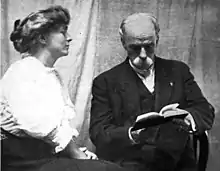Hildegarde Hawthorne | |
|---|---|
 Hildegarde Hawthorne and her father Julian Hawthorne, from a 1907 publication. | |
| Born | September 25, 1871 New York, United States |
| Died | December 10, 1952 Danbury, Connecticut, United States |
| Other names | Hildegarde Oskison |
| Occupations |
|
| Spouse | |
| Parent(s) | Julian Hawthorne Minnie Amelung |
Hildegarde Hawthorne (September 25, 1871 – December 10, 1952) was an American writer of supernatural and ghost stories, a poet and biographer.
Family
Born on September 25, 1871, in New York City, Hildegarde Hawthorne was the granddaughter of Nathaniel Hawthorne (1804–1864) and eldest child of Julian Hawthorne (1846–1934) and Minnie Amelung Hawthorne.[1][2] She lived in Germany, England, and Jamaica as a child.[3]
Career
At age sixteen Hildegarde began selling articles to the children's magazine St. Nicholas. Her supernatural short story "Perdita," was published in the March 1897 Harper's Magazine.[4] She wrote biographies of Nathaniel Hawthorne, Henry Wadsworth Longfellow, Ralph Waldo Emerson, Henry David Thoreau, Thomas Paine, Matthew Fontaine Maury, and Oliver Wendell Holmes Sr.[1]
Hawthorne also wrote travel narratives, including Old Seaport Towns of New England (1916),[5] Rambles in Old College Towns (1917),[6] Corsica: The Surprising Island (1926),[7] Romantic Cities of California (1939),[8] and Williamsburg, Old and New (1941).[9]
Hawthorne marched in the 1913 women's suffrage parade in New York City.[10] She lived in California in the 1920s and 1930s.[11]
A collection of ghost stories by Hawthorne, The Faded Garden, was published in 1985, edited by Jessica Amanda Salmonson. Her work is sometimes found in anthologies of American women's writing.[3]
Personal life
Hildegarde Hawthorne married John Milton Oskison in 1920. She died in 1952, aged 81 years, in Danbury, Connecticut.
References
- 1 2 Hanley, Terence E. (2012-12-06). "Tellers of Weird Tales: Hildegarde Hawthorne (1871-1952)". Tellers of Weird Tales. Retrieved 2020-01-04.
- ↑ "Genius of Writing in Hawthorne Kin". Lansing State Journal. 1930-03-21. p. 14. Retrieved 2020-01-04 – via Newspapers.com.
- 1 2 Lundie, Catherine A. (1996). Restless Spirits: Ghost Stories by American Women, 1872-1926. Univ of Massachusetts Press. p. 68. ISBN 978-1-55849-056-7.
- ↑ Hawthorne, Hildegarde (March 1897). "Perdita". Harper's Magazine. ISSN 0017-789X. Retrieved 2020-01-04.
- ↑ Hawthorne, Hildegarde (1916). Old Seaport Towns of New England. Dodd, Mead.
- ↑ Hawthorne, Hildegarde. (1917). Rambles in old college towns. New York: Dodd, Mead & Co.
- ↑ "Corsica the Surprising Island by Hildegarde Hawthorne". The Kelmscott Bookshop. Retrieved 2020-01-04.
- ↑ Hawthorne, Hildegarde. Romantic Cities of California (1939), in the collection of the Metropolitan Museum of Art.
- ↑ Hawthorne, Hildegarde (1941). Williamsburg, Old and New. D. Appleton-Century Company.
- ↑ Seger, Donna (2016-09-11). "Hildegarde Hawthorne Hits Salem". Streets of Salem. Retrieved 2020-01-04.
- ↑ "Story Treat for Children at Ukiah Library". Ukiah Republican Press. 1935-05-15. p. 4. Retrieved 2020-01-04 – via Newspapers.com.